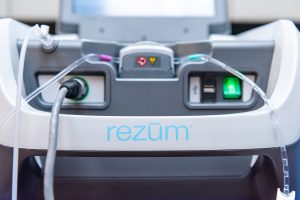Rezum is a relatively new, minimally invasive treatment for benign prostatic hyperplasia (also known as BPH or prostate enlargement).
Rezum is a relatively new, minimally invasive treatment for benign prostatic hyperplasia (also known as BPH or prostate enlargement). In this blog, we’ll take a look at the pros and cons of Rezum treatment, helping you to make a better-informed decision when it comes to treating your BPH.
- Image credit James McPherson Photograph.
BPH is one of the most common non-cancerous conditions affecting men worldwide. It is expected that almost 90% of men will have the age-related condition by the time they’re 85 years old. BPH can have a pronounced impact on a man’s quality of life; the enlarged prostate causes numerous urinary symptoms that affect not only the patient, but in many cases their partner too.
Pros and cons of Rezum treatment: Understanding the procedure
In order to be able to discuss the pros and cons of Rezum treatment, it is first necessary to understand a little bit more about the procedure. Rezum treatment for BPH is a relatively new therapy that utilizes water vapour to treat the enlarged prostate tissue.
Rezum treatment is performed under general anaesthetic, using a cystoscope that is inserted via the urethra. There are no incisions involved. A small handheld device is used to direct radiofrequency-generated steam (water vapour) to the enlarged prostate tissue. The steam causes degeneration of the enlarged tissue, which is eventually absorbed by the body’s natural healing processes, leading to shrinking of the prostate.
Once this extra prostate tissue is removed, the urethra opens up, reducing BPH symptoms.
Pros and cons of Rezum treatment: The advantages
When considering the pros and cons of Rezum treatment, the following are clear advantages of this type of therapy for BPH:
- It is minimally invasive: there are no incisions involved
- It preserves sexual function: this is a clear advantage over other, more traditional procedures for BPH, that often impair sexual function
- It offers patients both short-term and long-term outcomes: urine flow, bladder pressure and bladder emptying are generally improved within 2 weeks following the procedure, and urinary urgency, frequency and nocturia are improved within about 3 months, often with complete improvement in urinary symptoms overall for the patient.
Pros and cons of Rezum treatment: The disadvantages
As part of discussing the pros and cons of Rezum treatment, the following disadvantages should be considered and discussed with your urological surgeon:
- Not all prostates are suitable depending upon the size and anatomy
- It requires the placement of a catheter for 3-5 days following the procedure, due to the initial swelling of the prostate
- Some discomfort when urinating may be experienced in the 4-6 week period following the treatment, and this may also be accompanied by blood in the urine or semen (this is similar to other treatments)
- Rezum cannot be performed on patients who have a penile prosthesis or urinary implant.
Pros and cons of Rezum treatment: Making an informed decision
During your consultation with your urologist, they will go through the pros and cons of Rezum treatment with you, and you will have an opportunity to ask any questions or address concerns that you may have regarding the procedure.
Your urologist will be able to advise you on whether you are a suitable candidate for this minimally invasive procedure to treat BPH, and if not, they will be able to recommend an appropriate treatment for your condition.
More questions about the pros and cons of Rezum treatment?
If you wish to make an appointment to discuss the pros and cons or Rezum treatment, or to discuss your suitability for this procedure with a specialist urologist at Melbourne Urology Centre, please contact us. Our staff can be reached by telephone, or by completing the online booking form. Please note that a referral from your GP will be required in order to confirm your appointment.



